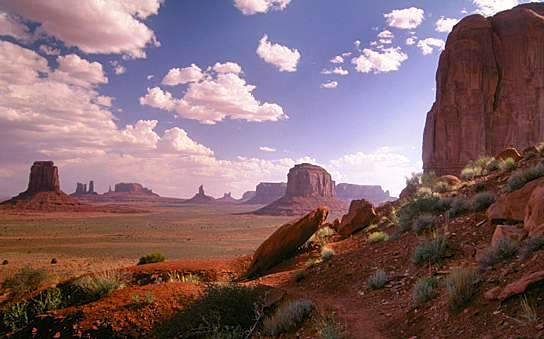The largest Native American reservation in the country covers over 27,000 square miles in northeastern Arizona and smaller adjoining parts of Utah and New Mexico. A world unto itself, the Navajo Nation is large enough to contain the smaller Hopi Reservation and world-famous sights such as Monument Valley and Canyon de Chelly National Monument, with vast land to spare. It is home to some 250,000 tribe members who are spread thinly across the high desert, rivers and mountains of Diné Bikéyah, as the Navajo call their homeland.

Many still live in the traditional ways, farming or herding sheep, horses and cattle, and conducting ceremonies in eight-sided buildings called hogans to nurture a state of spiritual harmony known as hozho.
Gallup, New Mexico, is the commercial centre of ‘the rez’, but Window Rock, Arizona, is its administrative hub. Here you’ll find the tribe’s council chamber and police headquarters, as well as a small zoo (involved in reintroducing the wolf to the Arizona wild) and the Navajo Nation Museum, Library and Visitor Centre, with displays on tribal history, geology and archaeology. On the way in or out of town, stop by the Hubbell Trading Post, known for its Navajo, Hopi and Zuni crafts. The trading post today is more a living museum than a store, continuing its traditional role as a place for meeting people and exchanging news.
Tuba City, Arizona, is one of the most diverse communities on the reservation, with many Anglo and Hopi residents as well as members of other native tribes. It sits in one of the most eye-catching stretches of the Painted Desert, and is home to the historic Tuba Trading Post, a two-storey showroom built in 1870 that’s one of the best places to shop for jewellery and other crafts.
Between Tuba City and Monument Valley on Highway 160 is the turn-off for little-visited Navajo National Monument, which protects three of the most impressive Anasazi ruins in the Southwest. The stunning 100-room Keet Seel cliff dwellings are a 17-mile round-trip hike from the Visitor Centre, but the trip is well worth it.
Encircled by the much larger Navajo Reservation, the Hopi Indian Reservation (sometimes referred to as Hopiland) consists of 12 ancient villages and a handful of more-recent settlements spread across three high, narrow mesas. Tribe members have lived in a few of these villages for well over 800 years, making them some of the oldest continually inhabited settlements in North America.
Adobe buildings on the edge of 600-foot-high flat-topped mesas give the reservation a strong sense of history, and the tribe—with some 5,000 members living here—is one of the most traditional in the country. Visitors are welcome to the Tutsqua, the Hopi ancestral lands, but they’re expected to behave with respect, and photography or recording of any kind are strictly prohibited at all times. One of the best ways to experience Hopiland is on a private tour with a tribe member, who will lift the veil on a number of the Hopi’s religious beliefs, which have stayed remarkably pure over the millennia.
